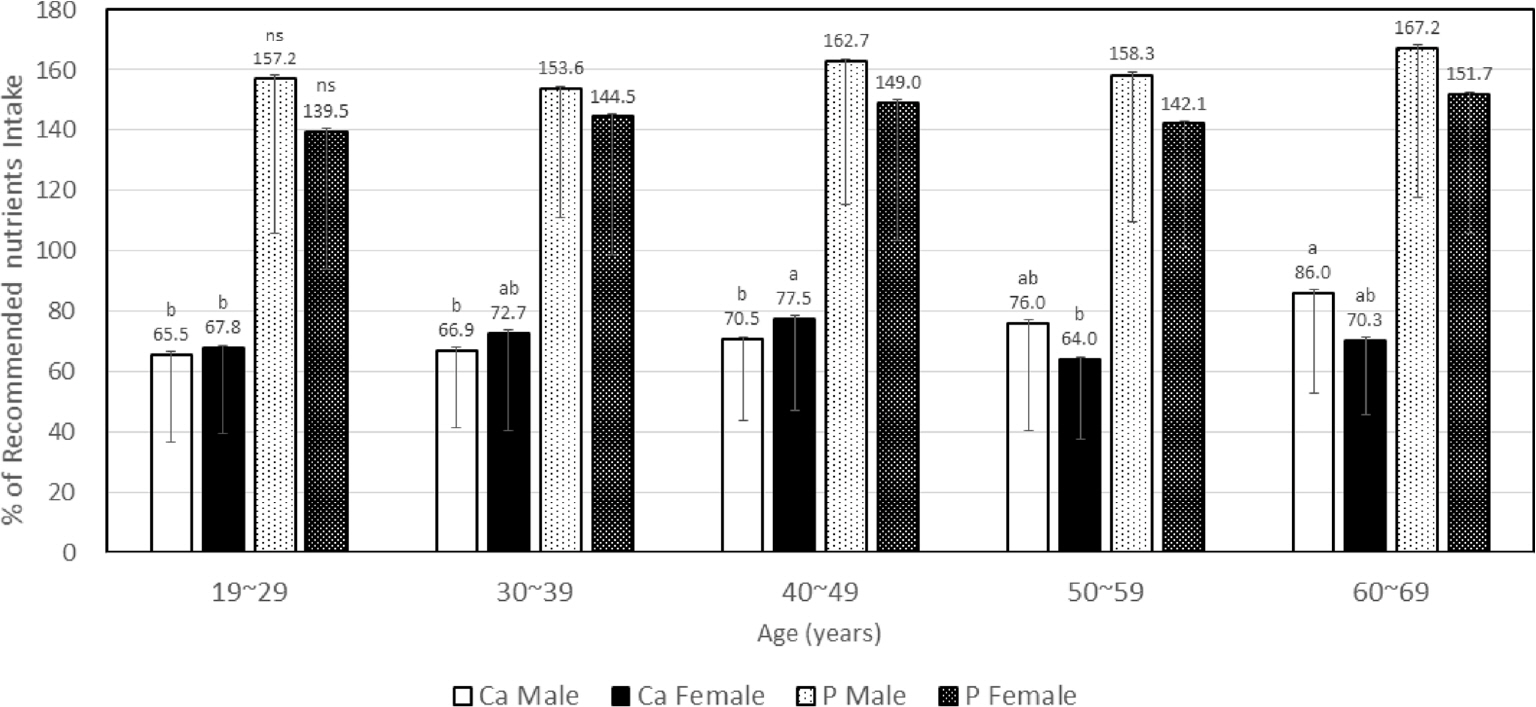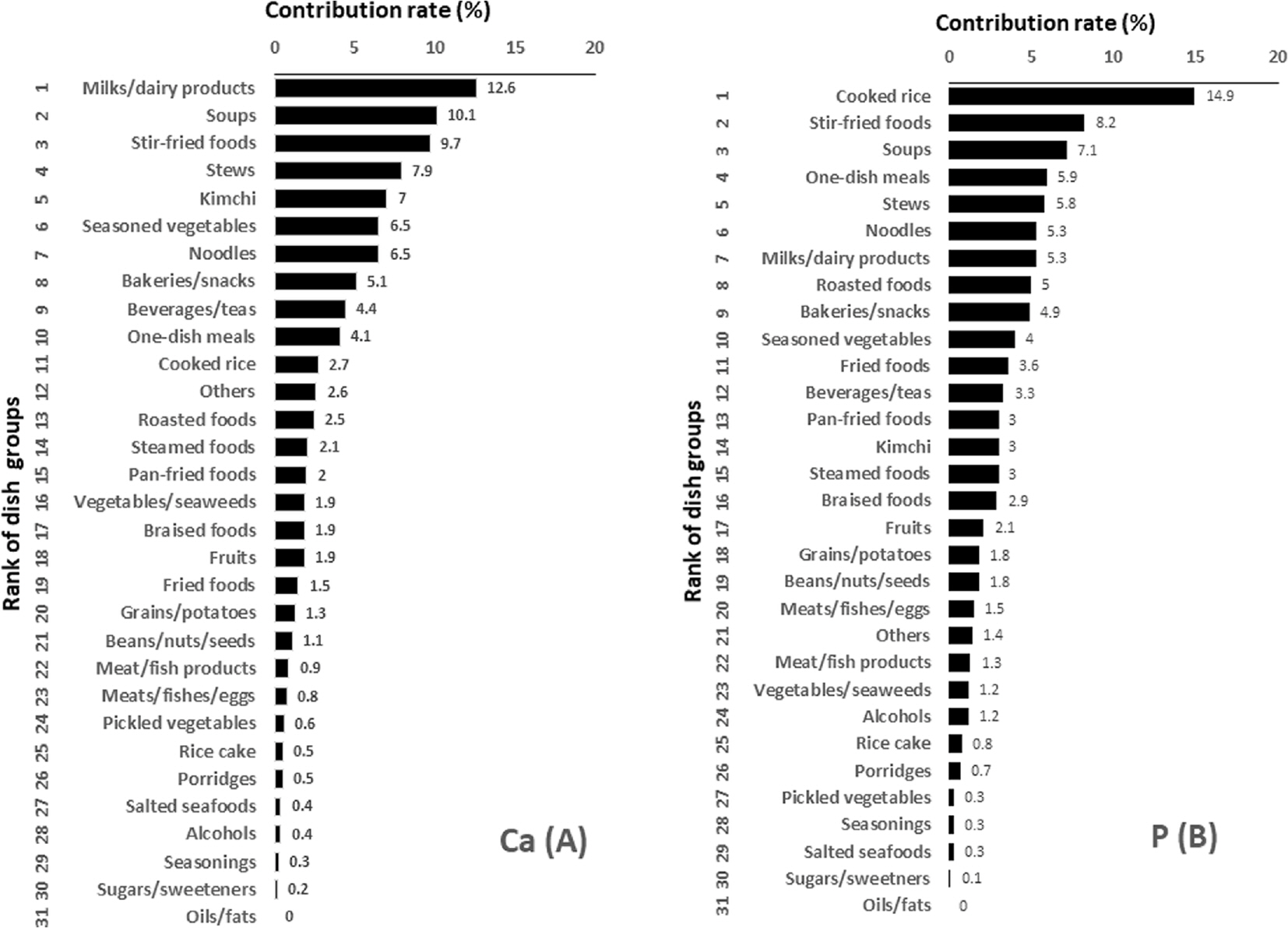Korean J Community Nutr.
2020 Feb;25(1):32-47. 10.5720/kjcn.2020.25.1.32.
Analysis of Dietary Calcium and Phosphorus Intakes and Contribution Rates of Major Dish Groups according to Gender, Age, and Region in Korea
- Affiliations
-
- 1Department of Food Science and Nutrition, Kyungpook National University, Daegu, South Korea, Professor.
- 2Division of Food Science, Kongju National University, Yesan, South Korea, Professor.
- 3Department of Food and Nutrition, Chungbuk National University, Cheongju, South Korea, Professor.
- 4Department of Food Science and Nutrition, Pukyong National University, Busan, South Korea, Professor.
- 5Department of Food and Nutrition, Myongji University, Yongin, South Korea, Professor.
- 6Department of Food and Nutrition, Dongshin University, Naju, South Korea, Professor.
- 7Division of Food and Nutrition, Research Institute for Human Ecology, Chonnam National University, Gwangju, South Korea, Professor. yrhuh@jnu.ac.kr
- KMID: 2471306
- DOI: http://doi.org/10.5720/kjcn.2020.25.1.32
Abstract
OBJECTIVES
Calcium (Ca) is an insufficiently consumed nutrient, whereas phosphorus (P) intake has exceeded the recommended intake level in Korea over the past decade. The purpose of this study was to analyze dietary Ca and P intakes and their contribution rate according to dish groups.
METHODS
A 24-hour dietary recall survey of 640 healthy adults (aged 19-69 years) was undertaken twice in four Korean provinces. Dietary Ca and P intakes and their rates of contribution from 31 major dish groups were analyzed and compared by gender, age group, and region.
RESULTS
The average Ca and P intakes of the subjects were 542.1 ± 222.2 mg/d and 1,068.3 ± 329.0 mg/d, respectively. The intakes of Ca and P as percentages of recommended nutrients intake (RNI%) were 71.7 ± 29.8% and 152.6 ± 47%, respectively, and the percentages under the estimated average requirement were 60.3% for Ca and 3.8% for P. The RNI% of Ca was not significantly different between males and females, but was significantly higher in subjects in the sixties age group than in other age groups and was significantly lower in the Korean capital than in other regions. The RNI% of P did not significantly differ by gender or age groups, but it was significantly higher in the capital than in Gyeong-sang. The five major dish groups contributing to Ca intake (contribution rate) were milks/dairy products 69.2 ± 109.2 mg/d (12.6%), soups 55.6 ± 69.6 mg/d (10.1%), stir-fried foods 53.1 ± 70.7 mg/d (9.7%), stews 43.4 ± 85.4 mg/d (7.9%), and kimchi 38.4 ± 31.8 mg/d (7.0%). The five major dish group contributing to P intake (contribution rate) were cooked rice 160.7 ± 107.1 mg/d (14.9%), stir-fried foods 88.5 ± 89.4 mg/d (8.2%), soups 76.7 ± 85.8 mg/d (7.1%), one-dish meals 63.3 ± 94.4 mg/d (5.9%), and stews 62.6 ± 89.3 mg/d (5.8%). The dish groups contributing to Ca and P intakes differed somewhat by gender, age group, and region.
CONCLUSIONS
Programs to improve the nutritional status of Ca and P intakes should consider the differences in Ca and P contribution rates by dish groups as well as by gender, age group, and region.
Keyword
MeSH Terms
Figure
Reference
-
References
1. Cashman KD. Calcium intake, calcium bioavailability and bone health. Br J Nutr. 2002; 87(S2):S169–S177.
Article2. Flynn A. The role of dietary calcium in bone health. Proc Nutr Soc. 2003; 62(4):851–858.
Article3. Matkovic V, Goel PK, Badenhop-Stevens NE, Landoll JD, Li B, Ilich JZ, et al. Calcium supplementation and bone mineral density in females from childhood to young adulthood: a randomized controlled trial. Am J Clin Nutr. 2005; 81(1):175–188.
Article4. Movassagh EZ, Vatanparast H. Current evidence on the association of dietary patterns and bone health: A scoping review. Adv Nutr. 2017; 8(1):1–16.
Article5. Weaver CM. Nutrition and bone health. Oral Dis. 2017; 23(4):412–415.
Article6. Lee YK, Hyun TS, Oh SY, Park HR, Ro HK, Heo YR, et al. Serum calcium is associated with dyslipidemia in a free-living Korean population: a cross sectional study. Trace Elem Electrolytes. 2017; 34(4):159–165.7. Pannu PK, Calton EK, Soares MJ. Calcium and vitamin D in obesity and related chronic disease. Adv Food Nutr Res. 2016; 77:57–100.
Article8. Peterlik M, Cross HS. Vitamin D and calcium insufficiency-related chronic diseases: molecular and cellular pathophysiology. Eur J Clin Nutr. 2009; 63(12):1377–1386.
Article9. Chrysant SG, Chrysant GS. Controversy regarding the association of high calcium intake and increased risk for cardiovascular disease. J Clin Hypertens (Greenwich). 2014; 16(8):545–550.
Article10. Ministry of Health and Welfare, Korea Center for Disease Control and Prevention. Korea Health Statistics 2017: Korea National Health and Nutrition Examination Survey (KNHANES VII-2). Sejong: Ministry of Health and Welfare;2018.11. Ministry of Health and Welfare, The Korean Nutrition Society. Dietary reference intake for Koreans 2015. Sejong: Ministry of Health and Welfare;2015. p. 570–637.12. Calvo MS, Tucker KL. Is phosphorus intake that exceeds dietary requirements a risk factor in bone health? Ann NY Acad Sci. 2013; 1301(1):29–35.
Article13. Calvo MS, Uribarri J. Public health impact of dietary phosphorus excess on bone and cardiovascular health in the general population. Am J Clin Nutr. 2013; 98(1):6–15.
Article14. Ito S, Ishida H, Uenishi K, Murakami K, Sasaki S. The relationship between habitual dietary phosphorus and calcium intake, and bone mineral density in young Japanese women: a cross-sectional study. Asia Pac J Clin Nutr. 2011; 20(3):411–417.15. Gutiérrez OM, Luzuriaga-McPherson A, Lin Y, Gilbert LC, Ha SW, Beck GR Jr. Impact of phosphorus-based food additives on bone and mineral metabolism. J Clin Endocrinol Metab. 2015; 100(11):4264–4271.
Article16. Lee AW, Cho SS. Association between phosphorus intake and bone health in the NHANES population. Nutr J. 2015; 14(2):28.
Article17. Choi YS. Development of research methods for determination of the dietary reference intakes for calcium. Cheongju: Korea Center for Disease Control and Prevention;2012.18. Jeong HK, Kim JY, Lee HS, Kim JY. The effect of dietary calcium and phosphate levels on calcium and bone metabolism in rats. Korean J Nutr. 1997; 30(7):813–824.19. Vorland CJ, Stremke ER, Moorthi RN, Hill Gallant KM. Effects of excessive dietary phosphorus intake on bone health. Curr Osteoporos Rep. 2017; 15(5):473–482.
Article20. Lee YK. Development of sodium adaptation index based on dietary habits of Korean. Cheongju: National Institute of Food and Drug Safety Evaluation;2016.21. Ministry of Health and Welfare, Korea Center for Disease Control and Prevention. Korea Health Statistics 2012: Korea National Health and Nutrition Examination Survey (KNHANES V). Sejong: Ministry of Health and Welfare;2013.22. Bristow SM, Gamble GD, Stewart A, Horne L, House ME, Aati O, et al. Acute and 3-month effects of microcrystalline hydroxyapatite, calcium citrate and calcium carbonate on serum calcium and markers of bone turnover: a randomised controlled trial in postmenopausal women. Br J Nutr. 2014; 112(10):1611–1620.
Article23. Lau EM, Woo J, Lam V, Hong A. Milk supplementation of the diet of postmenopausal Chinese women on a low calcium intake retards bone loss. J Bone Miner Res. 2001; 16(9):1704–1709.
Article24. Kim JY, Ahn BI. Effect of consumer's dietary lifestyle on consumption pattern of processed foods. Korean J Food Market Econ. 2015; 32(1):31–53.25. Host A, McMahon AT, Walton K, Charlton K. Factors influencing food choice for independently living older people: A systematic literature review. J Nutr Gerontol Geriatr. 2016; 35(2):67–94.26. Pechey R, Monsivais P. Socioeconomic inequalities in the healthiness of food choices: Exploring the contributions of food expenditures. Prev Med. 2016; 88:203–209.
Article27. Kim OY, Kwak SY, Kim B, Kim YS, Kim HY, Shin MJ. Selected food consumption mediates the association between education level and metabolic syndrome in Korean adults. Ann Nutr Metab. 2017; 70(2):122–131.
Article28. Shin BR, Choi YK, Kim HN, Song SW. High dietary calcium intake and a lack of dairy consumption are associated with metabolic syndrome in obese males: the Korean National Health and Nutrition Examination Survey 2010 to 2012. Nutr Res. 2016; 36(6):518–525.
Article29. Ministry of Health and Welfare, Office for Healthcare Policy. Korea Health Statistics 2015: Korea National Health and Nutrition Examination Survey (KNHANES VI-3). Sejong: Ministry of Health and Welfare;2016.30. Calvo MS, Lamberg-Allardt CJ. Phosphorus. Adv Nutr. 2015; 6(6):860–862.
Article31. Takeda E, Yamamoto H, Yamanaka-Okumura H, Taketani Y. Increasing dietary phosphorus intake from food additives: potential for negative impact on bone health. Adv Nutr. 2014; 5(1):92–97.
Article32. Lou-Arnal LM, Arnaudas-Casanova L, Caverni-Muñoz A, Vercet-Tormo A, Caramelo-Gutiérrez R, Munguía-Navarro P, et al. Hidden sources of phosphorus: presence of phosphorus-containing additives in processed foods. Nefrologia. 2014; 34(4):498–506.33. Shimada M, Shutto-Uchita Y, Yamabe H. Lack of awareness of dietary sources of phosphorus is a clinical concern. In Vivo. 2019; 33(1):11–16.
Article34. Korea Rural Economic Institute. The consumer behavior survey for food 2018. Naju: Korea Rural Economic Institute;2018.35. Adatorwovor R, Roggenkamp K, Anderson JJ. Intakes of calcium and phosphorus and calculated calcium-to-phosphorus ratios of older adults: NHANES 2005–2006 data. Nutrients. 2015; 7(11):9633–9639.
Article
- Full Text Links
- Actions
-
Cited
- CITED
-
- Close
- Share
- Similar articles
-
- A Comparison of Sources of Sodium and Potassium Intake by Gender, Age and Regions in Koreans: Korea National Health and Nutrition Examination Survey (KNHANES) 2010-2012
- A Longitudinal Study of Calcium and Phosphorus Intakes of Korean Infants from 1 to 3 Months in Breast-Fed vs Formula-Fed Infants
- Biochemical Characteristics and Dietary Intake according to the Frequency of Milk Consumption in Korean Adolescents: Data from the 2010~2011 Korea National Health and Nutrition Examination Survey
- Nutritional Evaluation of Traditional Fermented Foods by Dietary Intake of University Students in Chungnam
- The Comparison of Growth and Nutrient Intakes in Children with and without Atopic Dermatitis



